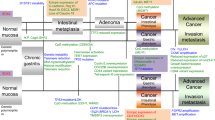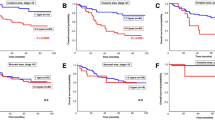Abstract
Background
Gastric carcinogenesis is a multistep process, involving multiple molecular alterations, including changes in cancer stem cells (CSCs). The present investigation was undertaken to determine whether changes in cancer stem cells could be utilized as a marker of progression of gastric carcinogenesis by examining the expression of gastric CSCs at different stages of carcinogenesis.
Methods
Ninety-three cases with 31 in each group of chronic superficial gastritis (CSG), chronic atrophic gastritis (CAG), or gastric cancer (GC) were analyzed immunohistochemically for proliferating cell nuclear antigen (PCNA) and Bcl-xl as biomarkers of proliferation and apoptosis, respectively, and CD44, CD166, and LGR5 levels by qRT-PCR as markers of gastric CSCs. Additionally, the levels of P53 and phosphorylated form of epidermal growth factor receptor (p-EGFR) were examined.
Results
While the levels of each of these biomarkers were found to be low to moderate in CSG and CAG patients, they were markedly increased in GC patients, in whom co-expression of CD44 with LGR5 and CD166 with p-EGFR was found to be the highest. We have also observed that although the expression of different CSC markers as well as the levels of p-EGFR were increased in precancerous lesions (CSG and CAG), they are further augmented in GC suggesting that they may play a pivotal role in the development and progression of gastric cancer.
Conclusions
Our observations suggest that the progression to gastric carcinogenesis from preneoplastic lesions such as superficial gastritis and chronic atrophic gastritis is associated with induction of CSCs together with increase in cell proliferation and inhibition of apoptosis.



Similar content being viewed by others
References
Crew KD, Neugut AI. Epidemiology of gastric cancer. World J Gastroenterol. 2006;12:354–62.
Genta RM. Atrophy and atrophic gastritis: one step beyond the Sydney system. Ital J Gastroenterol Hepatol. 1998;30:S273–5.
Correa P, Yardley JH. Grading and classification of chronic gastritis: one American response to the Sydney system. Gastroenterology. 1992;102:355–9.
Lipkin M, Correa P, Mikol YB, et al. Proliferative and antigenic modifications in human epithelial cells in chronic atrophic gastritis. J Natl Cancer Inst. 1985;75:613–9.
Kemper K, Grandela C, Medema JP. Molecular identification and targeting of colorectal cancer stem cells. Oncotarget. 2010;1:387–95.
Sanders MA, Majumdar AP. Colon cancer stem cells: implications in carcinogenesis. Front Biosci. 2011;16:1651–62.
Lobo NA, Shimono Y, Qian D, Clarke MF. The biology of cancer stem cells. Annu Rev Cell Dev Biol. 2007;23:675–99.
Clarke MF, Dick JE, Dirks PB, et al. Cancer stem cells—perspectives on current status and future directions: AACR Workshop on cancer stem cells. Cancer Res. 2006;66:9339–44.
Vermeulen L, Sprick MR, Kemper K, Stassi G, Medema JP. Cancer stem cells—old concepts, new insights. Cell Death Differ. 2008;15:947–58.
Al-Hajj M, Wicha MS, Benito-Herandez A, Morrison SJ, Clarke MF. Prospective identification of tumorigenic breast cancer. Proc Natl Acad Sci U S A. 2003;100:3983–8.
Collins AT, Berry PA, Hyde C, Stower MJ, Maitland NJ. Prospective identification of tumorigenic prostate cancer stem cells. Cancer Res. 2005;65:10946–51.
Dalerba P, Dylla SJ, Park IK, et al. Phenotypic characterization of human colorectal cancer stem cells. Proc Natl Acad Sci U S A. 2007;104:10158–63.
Li C, Heidt DG, Dalerba P, et al. Identification of pancreatic cancer stem cells. Cancer Res. 2007;67:1030–7.
Prince ME, Sivanandan R, Kaczorowski A, et al. Identification of a subpopulation of cells with cancer stem cell properties in head and neck squamous cell carcinoma. Proc Natl Acad Sci U S A. 2007;104:973–8.
Takaishi S, Okumura T, Tu S, et al. Identification of gastric cancer stem cells using the cell surface marker CD44. Stem Cells. 2009;27:1006–20.
Ghaffarzadehgan K, Jafarzadeh M, Raziee HR, et al. Expression of cell adhesion molecule CD44 in gastric adenocarcinoma and its prognostic importance. World J Gastroenterol. 2008;14:6376–81.
Liu YJ, Yan PS, Li J, Jia JF. Expression and significance of CD44s, CD44v6, and nm23 mRNA in human cancer. World J Gastroenterol. 2005;11:6601–6.
Barker N, Huch M, Kujala P, et al. LGR5(+ve) stem cells drive self-renewal in the stomach and build long-lived gastric units in vitro. Cell Stem Cell. 2010;6:25–36.
Van der Flier LG, Sabates-Bellver J, Oving I, et al. The intestinal Wnt/TCF signature. Gastroenterology. 2007;132:628–32.
Hsu SY, Liang SG, Hsueh AJ. Characterization of two LGR genes homologous to gonadotropin and thyrotropin receptors with extracellular leucine-rich repeats and a G protein-coupled, seven-transmembrane region. Mol Endocrinol. 1998;12:1830–45.
Swart GW. Activated leukocyte cell adhesion molecule (CD166/ALCAM): developmental and mechanistic aspects of cell clustering and cell migration. Eur J Cell Biol. 2002;81:313–21.
Van Kempen LC, Nelissen JM, Degen WG, et al. Molecular basis for the homophilic activated leukocyte cell adhesion molecule (ALCAM)–ALCAM interaction. J Biol Chem. 2001;276:25783–90.
Cayrol R, Wosik K, Berard JL, et al. Activated leukocyte cell adhesion molecule promotes leukocyte trafficking into the central nervous system. Nat Immunol. 2008;9:137–45.
Masedunskas A, King JA, Tan F, et al. Activated leukocyte cell adhesion molecule is a component of the endothelial junction involved in transendothelial monocyte migration. FEBS Lett. 2006;580:2637–45.
Weichert W, Knosel T, Bellach J, Dietel M, Kristiansen G. ALCAM/CD166 is overexpressed in colorectal carcinoma and correlates with shortened patient survival. J Clin Pathol. 2004;57:1160–4.
Ishigami S, Ueno S, Arigami T, et al. Clinical implication of CD166 expression in gastric cancer. J Surg Oncol. 2011;103:57–61.
Speer AL, Sala FG, Matthews JA, Grikscheit TC. Murine tissue-engineered stomach demonstrates epithelial differentiation. J Surg Res. 2011;171:6–14.
Rogers SJ, Harrington KJ, Rhys-Evans P, O-Charoenrat P, Eccles SA. Biological significance of c-erbB family oncogenes in head and neck cancer. Cancer Metastasis Rev. 2005;24:47–69.
Bianco R, Gelardi T, Damiano V, Ciardiello F, Tortora G. Rational bases for the development of EGFR inhibitors for cancer treatment. Int J Biochem Cell Biol. 2007;39:1416–31.
Sebastian S, Settleman J, Reshkin SJ, Azzariti A, Bellizzi A, Paradiso A. The complexity of targeting EGFR signalling in cancer: from expression to turnover. Biochim Biophys Acta. 2006;1766:120–39.
Dougherty U, Sehdev A, Cerda S, et al. Epidermal growth factor receptor controls flat dysplastic aberrant crypt foci development and colon cancer progression in the rat azoxymethane modal. Clin Cancer Res. 2008;14:2253–62.
Roberts RB, Min L, Wshington MK, et al. Importance of epidermal growth factor receptor signaling in establishment of adenomas and maintenance of carcinomas during intestinal tunorigenesis. Proc Natl Acad Sci U S A. 2002;99:1521–6.
Ye YW, Zhou Y, Yuan L, et al. Fibroblast growth factor receptor 4 regulates proliferation and antiapoptosis during gastric cancer progression. Cancer. 2011;117:5304–13.
Radovanovic D, Knezevic M, Canovic D, Acimovic L. Correlation between p53 expression and clinical-pathological characteristics of gastric cancer. Vojnosanit Pregl. 2011;68:832–6.
Ran ZH, Xu Q, Tong JL, Xiao SD. Apoptotic effect of epigallocatechin-3-gallated on the human gastric cancer cell line MKN 45 via activation of the mitochondrial pathway. World J Gastroenterol. 2007;13:4255–9.
Acknowledgments
The authors thank Dr. Yao Shi and Min M Li for advice and discussion of histopathological diagnoses. The authors also thank Li N Zhang for the statistical analysis.
Conflict of Interest
The authors have no financial disclosures or conflicts of interests to declare.
Author information
Authors and Affiliations
Corresponding author
Rights and permissions
About this article
Cite this article
Yang, L., Levi, E., Zhu, S. et al. Cancer Stem Cells Biomarkers in Gastric Carcinogenesis. J Gastrointest Canc 44, 428–435 (2013). https://doi.org/10.1007/s12029-013-9534-2
Published:
Issue Date:
DOI: https://doi.org/10.1007/s12029-013-9534-2




